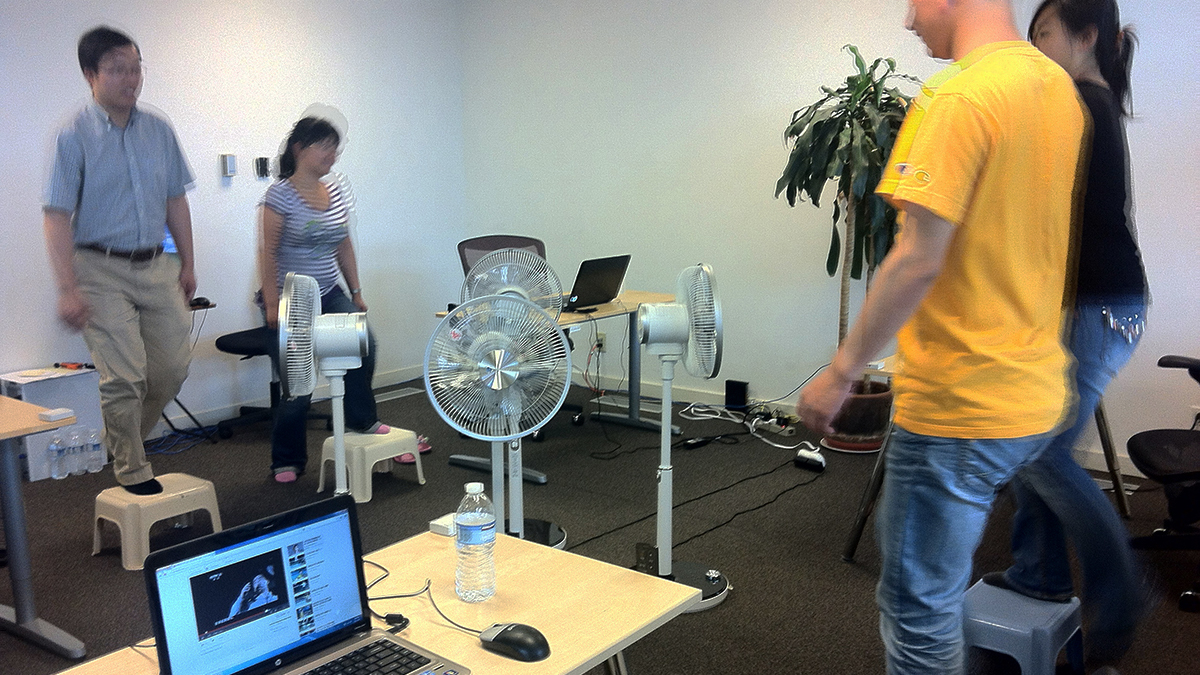Evaluating the potential effectiveness of various types of fans for low-energy comfort.
Status: Completed
Funding Sources: CBE Industry Consortium California Air Resources Board Armstrong World Industries
Project Objective
To optimize the design of air movement devices suitable for mounting in a range of positions with ceilings and furniture within a room, and to quantify their ability to produce fast-acting personal environmental control for occupants.
Project Results
Achieving the objectives of this project will promote the use of fan-powered air movement to reduce compressor-based cooling in both new and retrofitted office buildings. Efficiently targeted and modulated air movement in occupied spaces will make it possible to have acceptable comfort at higher ambient space temperatures. It will also strengthen the effectiveness of other energy efficient measures which may be inherently slow-acting or unpredictable, such as radiant ceilings/floors, and buildings designed to rely on natural ventilation. The technologies involved are especially applicable in California climates.
Significance to Industry
ASHRAE Standard 55 was recently revised to allow air movement in warm environments. This provides a major opportunity for new energy-efficient design strategies using air movement to enhance comfort. We estimate that very low-wattage fans (3 watts) producing one m/s (two mph) near each occupant can offset a 3K (6ºF) air temperature increase in the building, with substantial savings in HVAC energy, around 30% in mechanically conditioned buildings, and more if there is the possibility of switching to natural ventilation or evaporative cooling systems.
The potential for using fans in office buildings has not been adequately explored. There are a number of possible fan and nozzle configurations that can be attached to ceilings, office furniture, and partitions; however the products on the market are mostly a limited set of generic ceiling and desk fans. The comfort and energy impacts of optimized office fan systems at high ambient temperature has not been broadly determined, even though there are numerous studies of specific configurations that are very encouraging.
The opportunities for design improvements and new products are considerable. Room fans have great advantages in both new and retrofit designs since they do not involve modifying the HVAC system (only the reprogramming of setpoints), they are individually responsive to the occupancy (as with occupancy sensors or wireless controls), and they provide comfort with minimal time lag.
Research Approach
The following tasks have been completed:
1) Select promising configurations that integrate ceiling fans into a generic set of acoustical clouds or suspended ceilings. We will work with Armstrong World Industries and possible other interiors manufacturers on this. The fan heads will operate in both fixed and oscillating modes. We will install the systems in CBE’s Controlled Environment Chamber.
2) Test the performance with and without oscillation, and with supplemental personal fans operating both horizontally and vertically. Characterize the airflow patterns through physical measurements.
3) Conduct human subject tests to evaluate the comfort and perceived air quality effect of the fan systems.
4) Estimate energy savings of such systems by simulations.
5) Using the results, collaborate with Armstrong World Industries to develop an initial set of design specifications for integrating fans into building components.
Publications and Reports
Pasut, W., E. Arens, H. Zhang, S. Kaam, and Y. Zhai. 2013. Enabling energy-efficient approaches to thermal comfort using room air motion. Proceedings of Clima 2013, Prague. June.
Zhai, Y., H. Zhang, Y. Zhang, W. Pasut, E. Arens, and Q. Meng. 2013. Comfort under personally controlled air movement in warm and humid environments. Building and Environment. March.

